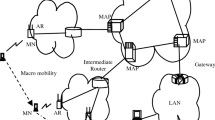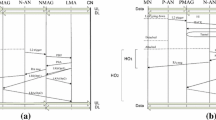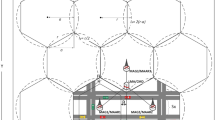Abstract
Excellent handover performance is essential for deploying real time applications over wireless Internets. In this paper, this study present a novel handover scheme for Mobile IPv6. The proposed scheme is based on an infrastructure, which is called Cross-layer Address Resolution (CAR). A smart message interaction for the Binding Update procedure is also introduced. The prototype is illustrated first and a buffering approach adopted to achieve zero packet loss.
The proposed scheme, which is called Seamless Handover for Mobile IPv6 (S-MIPv6), evolved from Fast Handover for Mobile IPv6 (F-MIPv6). The problems in F-MIPv6, such as triangle route and sequence disorder, are solved by the proposed scheme. The S-MIPv6 avoids building tunnels and reduces registration delay. It is capable of cooperating with a Mobility Anchor Point (MAP) to take advantage from hierarchical networks. The S-MIPv6 is modeled and simulated. In a practical case, the disruption duration is close to the Data Link layer handover latency (50–100 ms). We believe that the proposed S-MIPv6 is capable of providing seamless handover for time critical services.
Similar content being viewed by others
Explore related subjects
Discover the latest articles, news and stories from top researchers in related subjects.References
Perkins, C. (2002). RFC 2002—IP mobility support. URL reference: http://www.faqs.org/rfcs/rfc2002.html.
Johnson, D., Perkins, C., & Arkko, J. RFC 3775—mobility support in IPv6. URL reference: http://www.faqs.org/rfcs/rfc3775.html.
Akyildiz, I. F., Xie, J., & Mohanty, S. (2004). A survey of mobility management in next-generation all-IP-based wireless systems. IEEE Wireless Communications, 11(4), 16–28.
Koodli, R. (2005). Nokia Research Center, Fast handover for mobile IPv6. Internet draft, work in progress. URL reference: http://www.ietf.org/internet-drafts/draft-ietf-mobileip-fast-mipv6-08.txt.
Dimopoulou, L., Leoleis, G., & Venieris, I. (2005). Fast handover support in a WLAN environment: challenges and perspectives. IEEE Network, 19(3), 14–20.
Yao, W.-M., & Chen, Y.-C. (2004). An enhanced buffer management scheme for fast handover protocol. In Proceedings of international conference on distributed computing system workshops (ICDCSW’04) (pp. 896–901).
Ramjee, R., Varadhan, K., Salgarelli, L., Thuel, S. R., Wang, S.-Y., & La Porta, T. (2002). HAWAII: a domain-based approach for supporting mobility in wide-area wireless networks. IEEE/ACM Transactions on Networking, 10(3), 396–410.
Soliman, H., Castelluccia, C., El-Malki, K., & Bellier, L. (2003). Hierarchical mobile IPv6 mobility management (HMIPv6). Internet draft: draft-ietf-mobileip-hmipv6-08.txt.
Vivaldi, I., Habaebi, M. H., Ali, B. M., & Prakesh, V. (2003). Fast handover algorithm for hierarchical mobile IPv6 macro-mobility management. In Proceedings of Asia-Pacific conference on communications (APCC 2003) (Vol. 2, pp. 630–634).
Hsieh, R., Zhou, Z. G., & Seneviratne, A. (2003). S-MIP: a seamless handoff architecture for mobile IP. In Proceedings of INFOCOM 2003, March 2003 (Vol. 3, pp. 1774–1784).
Hsieh, R., & Seneviratne, A. (2002). Performance analysis on hierarchical mobile IPv6 with fast-handoff over TCP. In Proceedings of GLOBECOM, Taipei, Taiwan.
Perez-Costa, X., Torrent-Moreno, M., & Hartenstein, H. (2003). A performance comparison of mobile IPv6, hierarchical mobile IPv6, fast handover for mobile IPv6 and their combination. ACM Mobile Computing and Communications Review, 7(4), 5–19.
Lin, H., Fan, R., Zou, S., Lin, Y., & Cheng, S. (2003). An enhanced buffer forwarding control scheme in smooth handover to improve TCP performance. In Proceedings of personal, indoor and mobile radio communications symposium (PIMRC’2003), September 2003 (Vol. 1, pp. 476–481).
Cao, J., Zhang, L., Chan, H., & Das, S. K. (2004). Design and performance evaluation of an improved mobile IP protocol. In Proceedings of INFOCOM 2004, March 2004 (Vol. 1).
Yokota, H., Idoue, A., Hasegawa, T., & Kato, T. (2002). Link layer assisted mobile IP fast handoff method over wireless LAN networks. In Proceedings of MOBICOM 2002, September 2002.
Helmy, A., Jaseemuddin, M., & Bhaskara, G. (2003). Multicast-based mobility: a novel architecture for efficient micro-mobility. IEEE Journal on Selected Areas in Communications, 22(4), 677–690.
Li, L., & Abe, S. (2005). A network layer seamless handover scheme based on Xcast for wireless LANs. In Proceedings of IEEE wireless communications & networking conference (WCNC 2005), March 2005 (Vol. 3, pp. 1557–1582).
Chen, W., & Chao, H.-C. (2005). Proactive hand-off target orientation cache in fast handover for mobile IPv6. In Proceedings of IEEE WirelessCom 2005, June 2005.
Lee, J.-S., Min, J.-H., & Kim, S.-H. (2004). Considerations for designing fast handoff mechanisms in Mobile IPv6. In Proceedings of international conference on advanced computing technologies (ICACT’2004) (Vol. 1, pp. 21–24).
Author information
Authors and Affiliations
Corresponding author
Rights and permissions
About this article
Cite this article
Chen, WM., Chen, W. & Chao, HC. An efficient mobile IPv6 handover scheme. Telecommun Syst 42, 293 (2009). https://doi.org/10.1007/s11235-009-9187-4
Published:
DOI: https://doi.org/10.1007/s11235-009-9187-4




